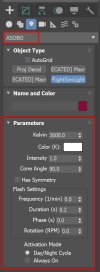- Messages
- 5,945
- Country
-

Any other question that is not specific to an aspect of development or tool can be posted in the General chat forum.
By following these guidelines we make sure that the forums remain easy to read for everybody and also that the right people can find your post to answer it.




3ds Max has access to the same exporter, you would select “Asobo” Lights, from the light creation panel, it’s well documented in the SDK and you have control over color, cone, flash, flash duration, range, etc.Dick, this is really interesting and a lot of developers need lights for their scenes. Can you provide some information about the visibility range of the lights?
Just starting a discussion about Scenery lights.
These are made from Blender 3.1 with the Official Asobo Blender addon:
View attachment 83730
None of these lights cast a shadow. Point, area, and sun seem to be identical.

 ), with a cone angle < 360 degrees.
), with a cone angle < 360 degrees.
Maybe because Asobo decided to dis Autodesk and provide better tools to the free platform, but as I suggested above, after exhausting Blender resources, you'll want to experiment with MCX, as I believe it provides more fidelity into light cone shapes.This may appear to be a Blender specific question


"extensions" : {
"ASOBO_macro_light" : {
"color" : [
1,
1,
1
],
"intensity" : 100,
"cone_angle" : 45.0,
"has_symmetry" : false,
"flash_frequency" : 0,
"flash_duration" : 0,
"flash_phase" : 0,
"rotation_speed" : 0,
"day_night_cycle" : false
}
},Here's the Asobo glTF code for lights:
This is the same code exported from either 3DS or Blender. The current Blender addon does not have a tick for day_night_cycle, but you can edit the glTF and set it to true.JSON:"extensions" : { "ASOBO_macro_light" : { "color" : [ 1, 1, 1 ], "intensity" : 100, "cone_angle" : 45.0, "has_symmetry" : false, "flash_frequency" : 0, "flash_duration" : 0, "flash_phase" : 0, "rotation_speed" : 0, "day_night_cycle" : false } },
I do not know the limit for intensity, but setting it very high messes up the sim. And I have no idea what has_symmetry does.
Also, this code doesn't have a light orb. That would be a separate object with the emissive property set to create a 'bulb'. The Simple Scenery example has a light pole object that shows this.






I altered the above Blender_Light_Sample including the editing of the day_night_cycle for the spotlight, and added a huge 200 meter plane under the ground to the LOD_2, which allows the light-splash to show 20000+ meters away.






